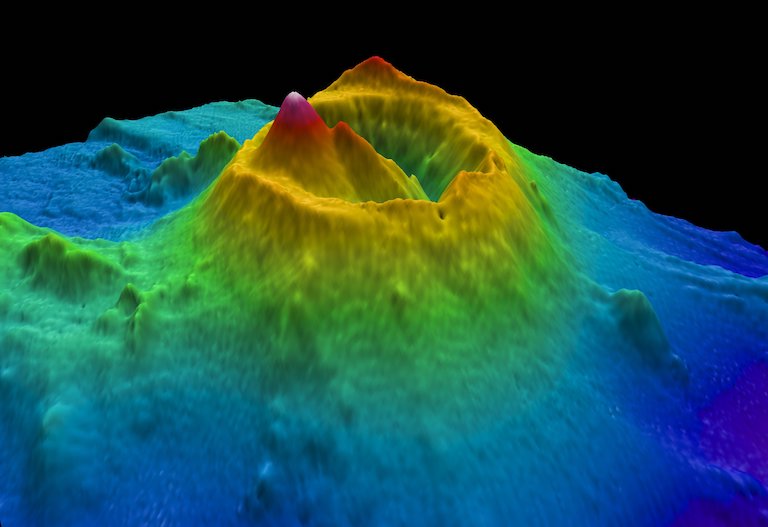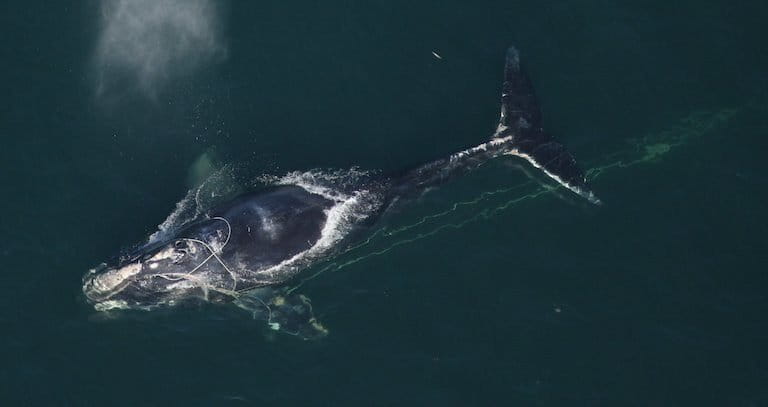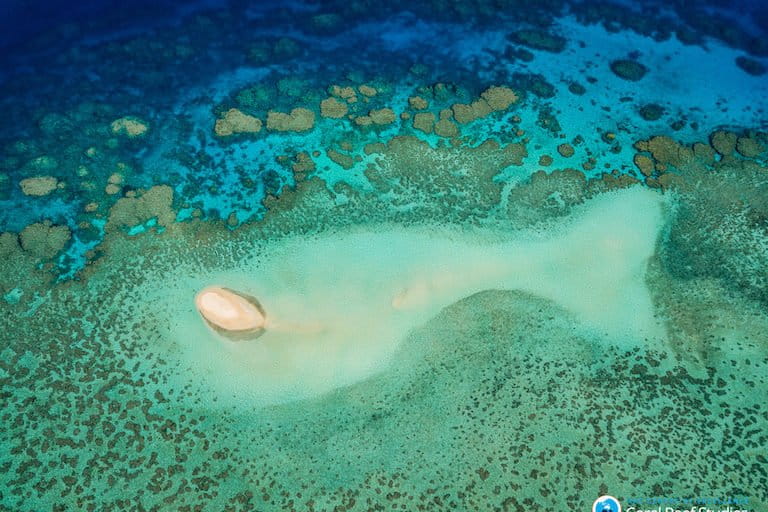- Marine scientists from the University of California, Santa Barbara, share their list of the top 10 ocean news stories from 2018.
- Hopeful developments included international efforts to curb plastic pollution and negotiate an international treaty to protect the high seas.
- Meanwhile, research documenting unprecedented ocean warming, acidification, and oxygen decline spotlighted the real-time unfolding of climate change.
- This post is a commentary. The views expressed are those of the authors, not necessarily Mongabay.
1. The race is on to map the seafloor
Is it true that we have explored the moon and Mars more thoroughly than the bottom of the ocean? Embarrassingly, yes. Only about 18 percent of the seafloor has been directly mapped, and only half of that at high resolution. That is a problem: imagine if only one-tenth of your own country had been mapped. That would present a challenge for key activities, like navigating, farming, and intelligently using natural resources. But our basic ignorance of the seafloor’s layout may change sooner rather than later. Excitingly, in 2018 the Seabed 2030 initiative became operational. The massively ambitious global effort, led by the Tokyo-based Nippon Foundation and an international consortium called General Bathymetric Chart of the Oceans, aims to finish mapping the world’s seafloor in the next 12 years. But to get it done they’ll need more money, more international collaborators, and more reliance on tech like efficient underwater drones.

2. World war on straws
2018 looked like a transformational year for our global effort to cut back on plastic pollution entering our ocean. First, five of the G7 countries (absent Japan and the United States) signed a charter to progressively reduce plastic waste. The European Union also made the bold step of banning single-use plastics by 2021, and numerous companies and governments bandedtogether in the Global Plastic Action Partnership and other initiatives to address this critical issue. Straws were in the crosshairs worldwide, with places from California to Jamaica instituting bans on their use, and so were plastic bags. Collectively, this year’s actions suggest the world may indeed be willing to start stemming this large and growing threat to ocean health.

3. A Paris Agreement for the shipping industry
Seaborne shipping accounts for more than 80 percent of global trade. This ocean traffic has a significant carbon footprint, accounting for about 3 percent of global emissions. Emissions from the global transportation sector were left out when the Paris Agreement was drafted in 2015. In 2018, after several years of negotiations, the shipping industry reached its own agreement. The initial strategy of the International Maritime Organization to cut shipping emissions in half by 2050 falls short of aligning with Paris Agreement targets, but represents a positive step toward decarbonizing the industry.

4. Milestone for marine parks
The clock is ticking toward a 2020 deadline to protect 10 percent of the ocean, as agreed upon within the United Nations. How is the world doing? A recent surge in new ocean parks has taken us past 7 percent. But the quality of these marine protected areas varies hugely between countries. In 2018, the United Kingdom upped the ante by calling upon the world to protect 30 percent of the ocean by 2030 to maximize the yields of jobs, food, and biodiversity protection that these protected zones can provide. Whether the world takes on this important challenge remains to be seen.

5. Feeling the heat from climate change
The effects of climate change on land were impossible to ignore this year, with increasingly severe floods, droughts and wildfires. The magnitude of impacts underwater were equally striking in 2018. The ocean was found to be more acidic this year than it has been in 2 million years. Marine heatwaves, which are happening more often and lasting longer, broke records around the globe. Research in 2018 also determined that the ocean has lost more than 2 percent of its oxygen since 1960, a particularly worrying trend since the loss of oxygen in warming water played a key role in our planet’s largest extinction event ever. An ocean that is overheating, acidifying and becoming harder to breathe in will present dire challenges to marine life and to all of us that depend upon it.

6. Spotlight on the high seas
In September 2018 the United Nations kicked off the first session to negotiate a treaty to better manage biodiversity in the high seas. Alongside these negotiations, new reports shed light on how countries use, and abuse, the international waters beyond national control. Researchers found that fishing activity on the high seas is dominated by wealthy countries, is plagued by labor abuses, and in many regions would be unprofitable without massive government subsidies. The next several years present a key opportunity for countries to craft and commit to a strong U.N. high seas biodiversity treaty and to cooperate with the World Trade Organization to finally eliminate harmful fisheries subsidies.

7. A year of polar change
This September, the container ship Venta Maersk, loaded with a cargo of fish and electronics, became the first container ship to traverse the Arctic Ocean via the Northern Sea Route. The trial passage, carried out by Copenhagen-based global shipping giant Maersk, portends a worrisome increase in industrial activity in a fragile polar environment already undergoing disproportionately rapid changes from climate change. Meanwhile, far to the south, efforts to increase protection for a large region of Antarctica that provides a home for blue whales (Balaenoptera musculus), penguins (family Spheniscidae) and orcas (Orcinus orca) were blocked by China, Russia and Norway.

8. Right whales hang on
North Atlantic right whales (Eubalaena glacialis) are one of the world’s most endangered marine mammals, with just over 400 individuals left and only 100 breeding females. 2017 was a truly disastrous year for the species, with the loss of at least 17 whales. Scientists pinned all nine deaths for which they could determine at least a suspected cause to human activity. 2018 has been, if not great, at least not as grim. The Canadian government made substantial and needed efforts to reduce the risk of entanglements in fishing gear and collisions with ships, which are the whales’ leading causes of death. And as far as scientists can tell, it has worked. No right whale deaths were detected in Canada this year. Unfortunately, three dead right whales were found in United States waters, leaving room for improvement in the U.S. One interesting initiative that got off the ground in 2018 aims to reinvent fishing gear to eliminate long ropes that can entrap whales and other sea life.

9. Trump vs. the Sea
Last year, President Donald Trump announced that the U.S. would withdraw from the Paris Agreement. But that’s just the tip of the iceberg in terms of the damage his administration is inflicting on the ocean. This year it attacked marine national monuments, rescinded the environmentally focused National Ocean Policy via executive order, and authorized seismic surveys that can deafen whales in an effort to lay the groundwork for oil drilling in the Atlantic Ocean. Still, in a glimmer of hope that ocean stewardship could remain a bipartisan value, as it has been for decades, Trump signed the Save Our Seas Act to support cleaning up marine trash.

10. Ups and downs for the Great Barrier Reef
This is a complicated one. First, reports of the Great Barrier Reef’s death were greatly exaggerated two years ago. But a large portion of it certainly did die in 2016 and 2017 as a result of coral bleaching caused by climate change-induced ocean heat waves. This year’s prediction by the United Nations’ Intergovernmental Panel on Climate Change (IPCC) that up to 90 percent of all coral reefs will be dead by 2030 may be overly pessimistic, but the fact that responsible scientists are even considering the possibility is an indication of how serious things are for these underwater rainforests. The Great Barrier Reef did not suffer a bleaching event in 2018, but temperature forecasts look bad for 2019. The one-year respite afforded by 2018 has been nowhere near enough time for a recovery. While positive, we all hope this is not exactly what good ocean news is going to look like going forward.

Douglas McCauley began his career as a fisherman but later transitioned to marine science. He now serves as an associate professor at the University of California, Santa Barbara, and director of the Benioff Ocean Initiative. McCauley studies how marine ecosystems function and what management practices best support ocean health. Francis Joyce works as a researcher in the McCauley Lab at the University of California, Santa Barbara, where he has studied patterns of human impact on the ocean and the biology of endangered marine species.
FEEDBACK: Use this form to send a message to the editor of this post. If you want to post a public comment, you can do that at the bottom of the page.
